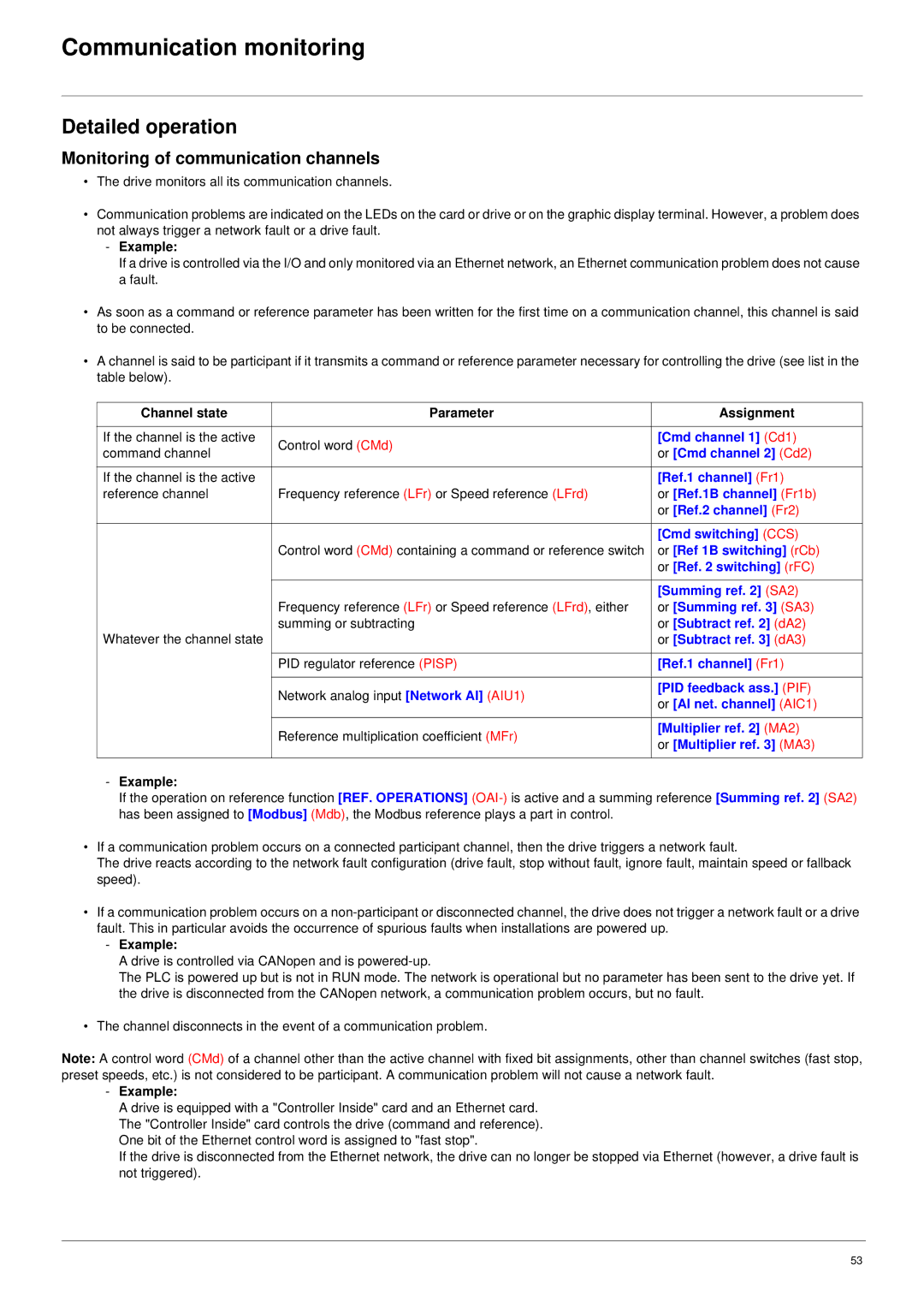
Communication monitoring
Detailed operation
Monitoring of communication channels
•The drive monitors all its communication channels.
•Communication problems are indicated on the LEDs on the card or drive or on the graphic display terminal. However, a problem does not always trigger a network fault or a drive fault.
-Example:
If a drive is controlled via the I/O and only monitored via an Ethernet network, an Ethernet communication problem does not cause a fault.
•As soon as a command or reference parameter has been written for the first time on a communication channel, this channel is said to be connected.
•A channel is said to be participant if it transmits a command or reference parameter necessary for controlling the drive (see list in the table below).
Channel state | Parameter | Assignment | |
|
|
| |
If the channel is the active | Control word (CMd) | [Cmd channel 1] (Cd1) | |
command channel | or [Cmd channel 2] (Cd2) | ||
| |||
|
|
| |
If the channel is the active |
| [Ref.1 channel] (Fr1) | |
reference channel | Frequency reference (LFr) or Speed reference (LFrd) | or [Ref.1B channel] (Fr1b) | |
|
| or [Ref.2 channel] (Fr2) | |
|
|
| |
|
| [Cmd switching] (CCS) | |
| Control word (CMd) containing a command or reference switch | or [Ref 1B switching] (rCb) | |
|
| or [Ref. 2 switching] (rFC) | |
|
|
| |
|
| [Summing ref. 2] (SA2) | |
| Frequency reference (LFr) or Speed reference (LFrd), either | or [Summing ref. 3] (SA3) | |
Whatever the channel state | summing or subtracting | or [Subtract ref. 2] (dA2) | |
| or [Subtract ref. 3] (dA3) | ||
|
|
| |
| PID regulator reference (PISP) | [Ref.1 channel] (Fr1) | |
|
|
| |
| Network analog input [Network AI] (AIU1) | [PID feedback ass.] (PIF) | |
| or [AI net. channel] (AIC1) | ||
|
| ||
|
|
| |
| Reference multiplication coefficient (MFr) | [Multiplier ref. 2] (MA2) | |
| or [Multiplier ref. 3] (MA3) | ||
|
| ||
|
|
|
-Example:
If the operation on reference function [REF. OPERATIONS]
•If a communication problem occurs on a connected participant channel, then the drive triggers a network fault.
The drive reacts according to the network fault configuration (drive fault, stop without fault, ignore fault, maintain speed or fallback speed).
•If a communication problem occurs on a
-Example:
A drive is controlled via CANopen and is
The PLC is powered up but is not in RUN mode. The network is operational but no parameter has been sent to the drive yet. If the drive is disconnected from the CANopen network, a communication problem occurs, but no fault.
•The channel disconnects in the event of a communication problem.
Note: A control word (CMd) of a channel other than the active channel with fixed bit assignments, other than channel switches (fast stop, preset speeds, etc.) is not considered to be participant. A communication problem will not cause a network fault.
-Example:
A drive is equipped with a "Controller Inside" card and an Ethernet card. The "Controller Inside" card controls the drive (command and reference). One bit of the Ethernet control word is assigned to "fast stop".
If the drive is disconnected from the Ethernet network, the drive can no longer be stopped via Ethernet (however, a drive fault is not triggered).
53
